Columbia Aircraft Manufacturing Company was originally founded as a privately held company in April 1995. The company focused on producing general aviation aircraft. In 1994, the National Aeronautics and Space Administration (NASA) launched a new project called the Advanced General Aviation Transport Experiments (AGATE).
This project was meant to rejuvenate a rapidly shrinking general aviation market. At this point, new regulations imposed by the Federal Aviation Administration (FAA) prevented many manufacturers from developing new general aviation aircraft. Additionally, legal liability lawsuit settlements have also prevented general aviation manufacturers from opting to produce new and improved aircraft, specifically due to the general aviation field becoming more and more unprofitable.
These factors made the general aviation market extremely slow-moving, and most of the aircraft that were produced in the early 1990s had limited improvements from aircraft produced in the 1970s.
Because of this, the used general aviation industry was booming in the 1980s and 1990s, and the available aircraft were shrinking. At the same time, kit aircraft were becoming more popular. NASA noticed this increasing popularity and decided to begin testing some of the popular kit aircraft as production aircraft. This included the Lancair IV, which NASA used as a testbed for advanced avionics. This encouraged Lancair to certify the aircraft as a type design aircraft.
To help accomplish this, the founder of Lancair, Lance Neibauer, established a new company called Pacific Aviation Composites USA in Redmond, Oregon. The new company flew a newly developed prototype in July 1996. The company then spent several years further developing the Lancair IV and eventually certified the aircraft in September 1998. The aircraft was introduced as the Columbia 300 shortly after. This aircraft helped revive the shrinking general aviation industry, and it encouraged other aircraft manufacturers to follow suit.
The Cessna acquisition of Columbia Aircraft
When the Columbia 300 was introduced, it was the fastest fixed-gear aircraft in the world. This encourages Neibauer’s company to continue developing general aviation aircraft. The company later released the turbocharged Columbia 400, which featured a glass cockpit. This avionics system was developed by the NASA AGATE program, as the design was similar to the Lancair IV, the testbed of advanced avionics for NASA. The Columbia 400 was introduced in March 2003.
The company later incorporated the major improvements recognized on the Columbia 400 into the Columbia 300, creating the Columbia 350, a popular general aviation aircraft. Pacific Aviation Composites USA later rebranded as Columbia Aircraft to ensure it marketed its general aviation aircraft properly.
However, although Columbia’s aircraft products were popular, they were slightly overshadowed by some of its direct competitors. This includes the Cirrus SR20, which rivaled the original Columbia 300. However, the Cirrus SR20 was brought to market several years before the Columbia 300 was certified, meaning it was more proven and, therefore, more popular in the general aviation industry. Because of this, Columbia saw slow sales of its later aircraft.
Eventually, in September 2007, Columbia Aircraft announced it was set to be purchased by Textron. Textron planned to merge Columbia Aircraft with Cessna, another popular general aviation manufacturer. After a bidding war between several investment companies, Textron announced it was cleared to purchase Columbia Aircraft in November 2007. Textron also announced it would continue production of the Columbia 350 and the Columbia 400, although they would be rebranded as the Cessna 350 and the Cessna 400. Textron originally planned to continue the production of these aircraft at the existing facilities in Bend, Oregon.
About the Cessna 350 Corvalis
As previously mentioned, the Cessna 350 was the basic rebrand of the popular Columbia 350, nicknamed the Corvalis. Officially, it was introduced as the Columbia 350 in late 2003. However, the upgraded variant of the Columbia received its type certification from the FAA on March 30, 2003. This included upgrades that were found in the Columbia 400, like a glass cockpit and an improved engine.
However, after over four years of production, Columbia Aircraft was purchased by Textron. The aircraft was rebranded as the Cessna 350 Corvalis after the purchase in late 2007. It was named the Corvalis after a town that was located just west of Bend, Oregon, which is where the aircraft was produced. However, the 2008 Recession hit the general aviation market pretty hard. The low number of sales forced Cessna to close the former Columbia Aircraft plant that was located in Bend, Oregon. It moved the production of the Cessna 350 to one of its facilities in Independence, Kansas.
However, Cessna was unable to correctly manufacture the composite parts of the advanced Columbia Aircraft at its new facility. During a production acceptance flight of a Columbia 400, the aircraft’s wing skin debonded from its wing spar, resulting in an emergency Airworthiness Directive (AD). Cessna was never able to recover the production of the aircraft, and due to the ongoing recession, Cessna ceased production of all the former Columbia aircraft in 2011.
Design and performance specifications of the Cessna 350 Corvalis
The Cessna 350 is a light aircraft with a low-wing and conventional wing configuration, and it utilized fixed landing gear. The Cessna 350 was powered by a Teledyne Continental IO-550 piston engine. This powerful engine provided the aircraft with approximately 310 horsepower. This helped the Cessna 350 achieve the following performance specifications:
|
Capacity |
Three additional passengers |
|---|---|
|
Length |
25 feet two inches |
|
Height |
Nine feet |
|
Wingspan |
36 feet one inch |
|
Maximum takeoff weight (MTOW) |
3,400 pounds |
|
Maximum speed |
191 knots (220 miles per hour) |
|
Range |
1,300 nautical miles (1,500 miles) |
|
Service ceiling |
18,000 feet |


